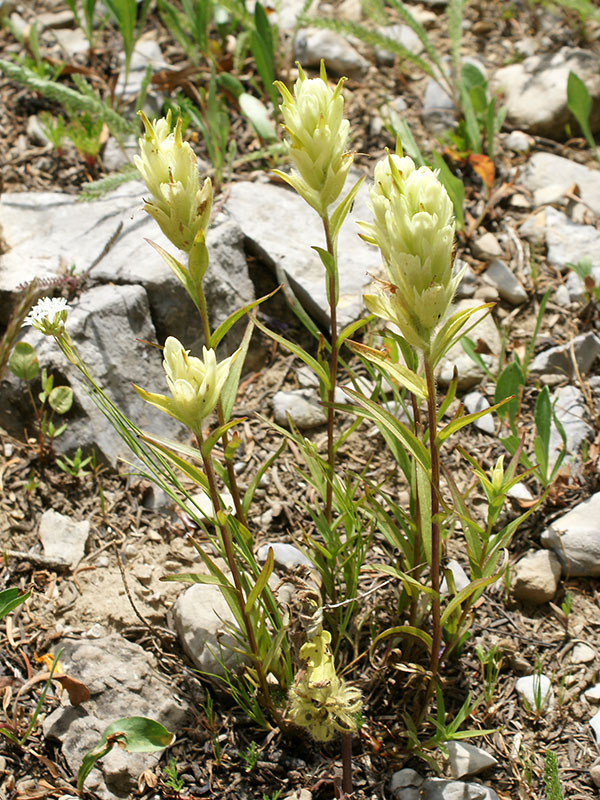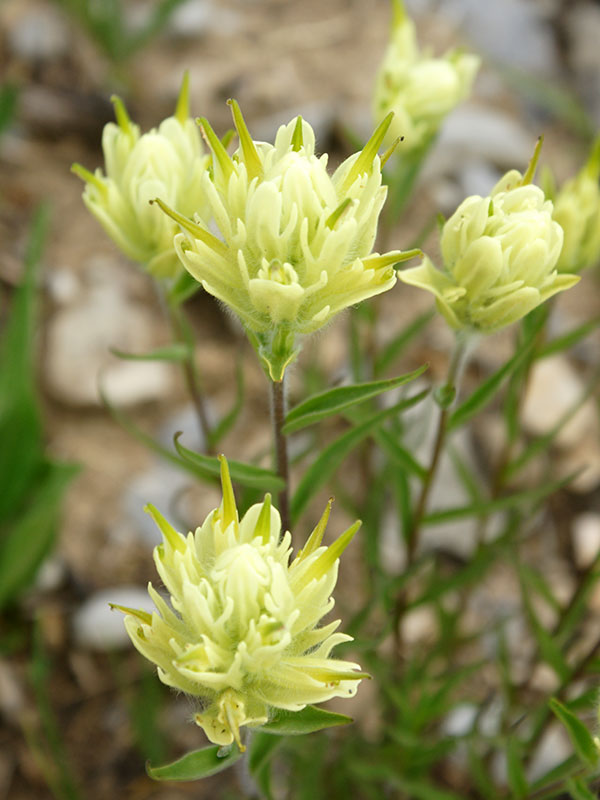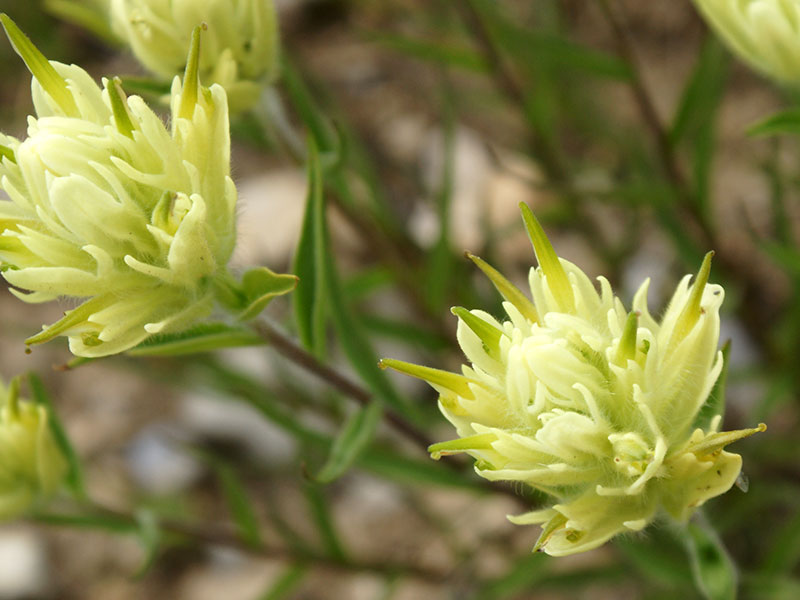Castilleja spp. / two yellow paintbrushes
- look like Indian paintbrushes (which they are), but yellow
- inflorescence bracts possibly lobed
- height ranges from less than 8″ to about 15″
- subalpine, alpine and tundra habitats, in clumps or spread out
- linear leaves without lobes, 3 prominent veins
- red to maroon, hairy stems
Perhaps known as: pale painted cup, alpine paintbrush, northern yellow paintbrush, northern painted cup, western Indian paintbrush
Species included: Castilleja septentrionalis, C. occidentalis
Additional confusing names: Castilleja sulphurea. May be a variety of C. rhexiifolia
See also: Castilleja spp. / paintbrushes
In the fields of taxonomy and systematics, there have historically been two types of scientists, the “lumpers” and the “splitters”. The former hesitates to divide possibly different plants into different species or varieties or subspecies. The latter revels in doing just that. The molecular systematists seem to be basically splitters, but the yellow paintbrushes have not been studied at that level. Since “I am not that kind of botanist”, I don’t do that – technically. Basically, I just want to hang a plausible name on what I have seen.
With respect to the yellow paintbrushes, things get complicated. Of course, the taxonomy and systematics aren’t at all clear, or I wouldn’t be writing this. We’re dealing with two (possible) species at this point. The first is the Labrador Indian paintbrush, C. septentrionalis. This is the most widespread of the paintbrushes, extending across the continent and to the farthest northern reaches of Canada. It is, however, restricted to “higher” elevations and northern latitudes. In the eastern part of its range, it is considered either threatened or endangered, but it is apparently not all that uncommon in Wydaho.
Like the other paintbrushes, the leaves of C. septentrionalis are alternately arranged. In this case they are linear, sessile, hairy and unlobed. The lower stems are usually glabrous while the upper stems are covered with spreading hairs. The stems are also strongly red to maroon. And like some of the red paintbrushes, the leaves have three prominent veins.
Looking at the inflorescences, the bracts (the yellow bits that you may at first think are flowers, but aren’t – see this overview), are broad, and may or may not be lobed. Even in the photos in the gallery here, it is clear that when lobed, the lobes can be hard to distinguish. The flowers themselves are tubular and pointed, with the stigma protruding past the end of the sheath. The sheath is made of the corolla enclosed in the calyx. The calyx is divided into two main lobes that can be peeled apart to show the rest of the flower structure. Inside, there are four long stamens. It is actually fun to peel the flowers apart.
Despite the long thin shape of the flowers, the seed capsules are more pear shaped and much shorter. The seeds are minuscule. Propagating any paintbrush from seed, or transplanting individuals, is unlikely to be successful because they are hemiparasitic and need some unspecified but specific host plant(s).
So if you are wandering up the trail at, say, Darby Wind Cave, and see a clump of yellow paintbrushes, it could well be C. septentrionalis.
But suppose you are higher – up towards the tree line where all the forbs and grasses are much shorter. Suppose you see a yellow paintbrush there. It, too, will be much shorter than at lower elevations. Now, it may be C. septentrionalis, or not. There, it might be C. occidentalis, western Indian paintbrush. Basically, everything I have said so far about C. septentrionalis holds for C. occidentalis as well, the only difference (as far as I can tell) being that the latter is considerably shorter (8 inches instead of 15) and is supposedly restricted to alpine zones and tundra.
But C. septentrionalis most often grows in subalpine meadows, scooching right up there next to the alpine and height is always at least partly determined by environment. One species is “pale yellow” while the other is “lemon yellow” – except when they are not. There may be subtle differences in the shapes of the leaves, but if, for example, you were to climb Tin Cup and then head north a mile and up another 1000 feet along the ridge overlooking the Green Lakes, you would be hard pressed to say when one species stopped and the other started.
To make matters worse, if that could be, some taxonomies say that the two species are the same, or even just varieties of C. rhexiifolia; others say that that one is a pink species but that it may hybridize with C. septentrionalis. This is probably based on the co-occurence of the two colors in some populations. And sometimes, they are called C. sulphurea.
For now, if I were to be making a “life list”, I would be happy to say that I have seen both the Labrador Indian paintbrush and the western paintbrush as I have poked around at different altitudes in meadows and on tundra. And you can say whatever you like… even that you have just seen the “yellow paintbrush.”
| Color | |
|---|---|
| Family | |
| Blossom size | |
| Inflorescence size | |
| Inflorescence type | |
| When? | |
| Where? |




